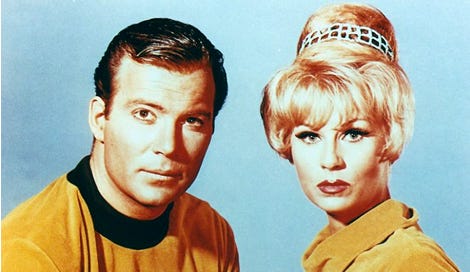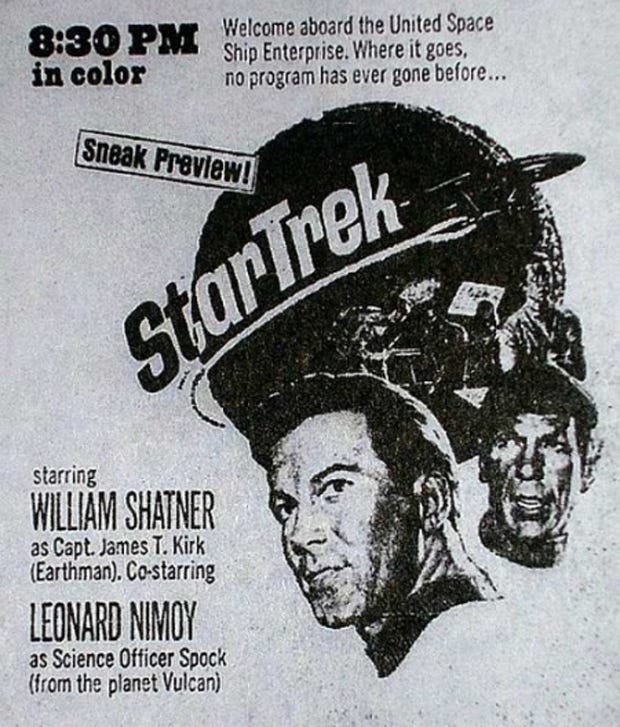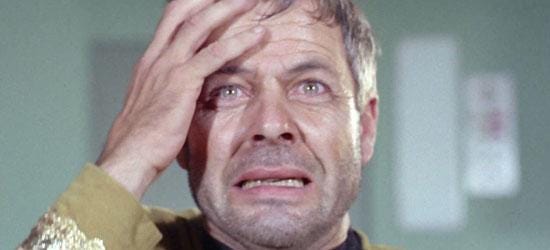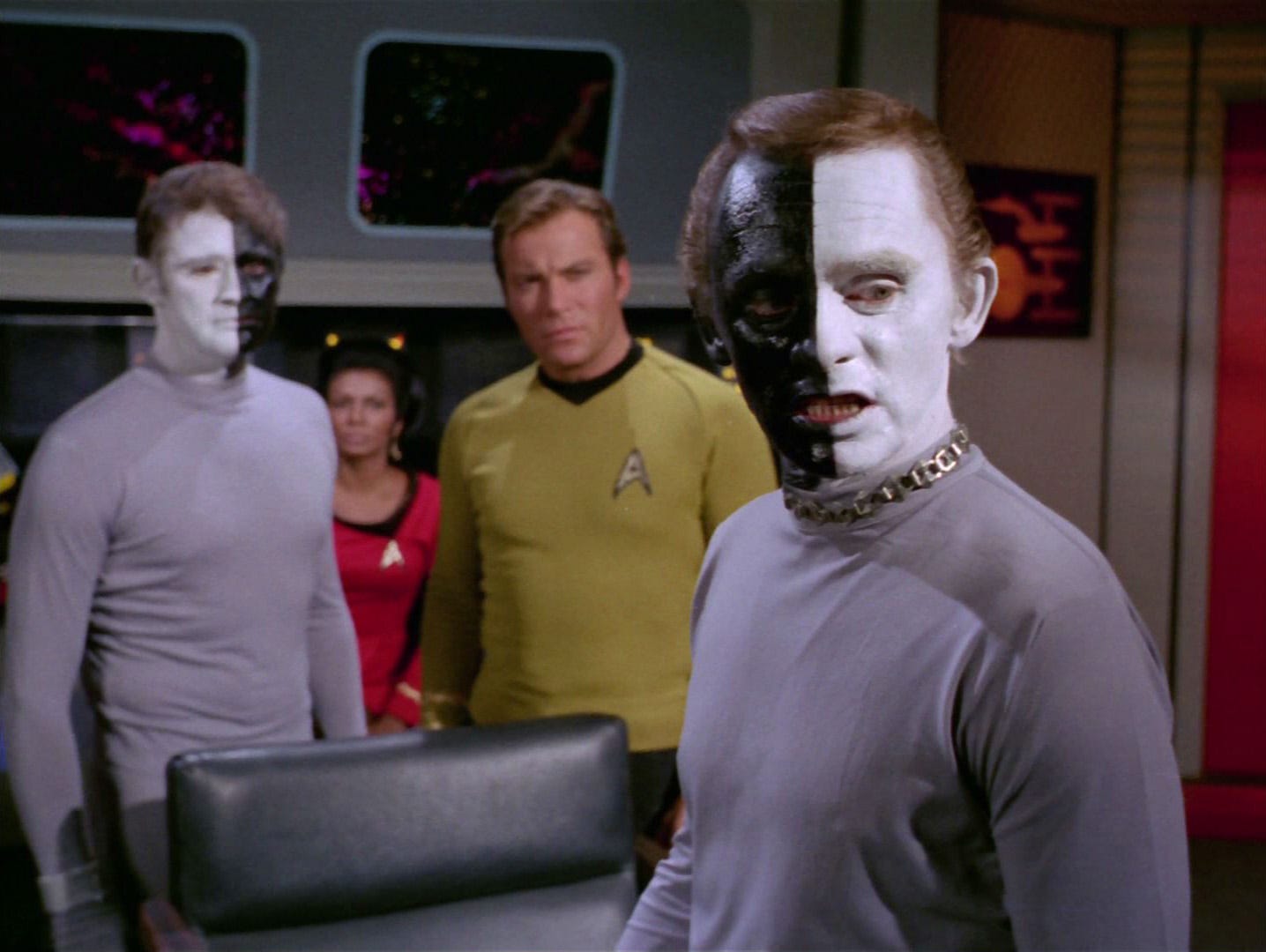To Go Boldly
Star Trek was a big part of my childhood, though I wouldn’t say I’m a Trekkie. I found a lot of other things to occupy my attention and Kirk and the gang faded into the background; a distinct stain on the carpet of my imagination but no longer damp. I can’t say I love revisiting it—being enthusiastic about phenomena as sizable as the Star Trek universe feels less like rediscovering an old fandom than celebrating a fan belt factory.
But then I rewatched an episode of the original show—the first I’d seen in a very, very long while. It was every bit as cheesy as I’d remembered, with the flimsy sets and the stentorian bellowing of, well William Shatner of course, but really everyone on the show goes to heroic lengths to be heard in the cheap seats. Who can forget the freakish face of William Wendom, contorted like a melting human head candle as he directs his spacecraft into the maw of an interstellar, planet-eating bullhorn? It was like he thought the camera might not be able to see him well enough. The plots are often as threadbare as the absurd special effects, hinging on improbable philosophical tchotchkes or deuses exing out of the machina like turds popping out of a hamster.
There’s something charming, though, about the high-school theater class production design, which leans heavily on cardboard sprayed with something that looks like a popcorn ceiling. As stingy as the budget for building materials and time must have been, there is care and artistry and creativity—sometimes awe-inspiring creativity—at work. Of particular note are the candy-colored buttons and switches adorning the various control panels that struggle to fill otherwise bare sets. These still retain a whiff of the fascination they conjured in my pre-adolescent mind with their bright hues and the caustic flickering within their jewel-like depths. With the satisfying clicks they emit when manipulated, they have a physicality that seems to have gone missing in an age of ubiquitous flat glass tablets.
That’s the heart of the emotional appeal: a simple world. A simple world where problems can always be solved with sufficient application of intelligence and grit—indeed, one of the conceits that runs through the show and the subsequent movies is that even explicitly unsolvable problems can’t stand up to the sheer humanity of the quartet of Kirk, Mister Spock,1 Doctor McCoy, and Scottie. It’s the opposite of a soap opera: everything gets wrapped up neat and tidy after fifty minutes. If there are any sort of lingering emotional losses, and these are almost always in the form of regrets from Kirk that he won’t be able to continue boning the alien chick of the week, they’re gone by the time the orchestra once more swells and we fade soothingly from an amnesic black to an image of the Enterprise circling a colorfully painted globe. If you believe that good stories should involve and impact the inner lives of their characters, beyond whatever brief dalliance with grief or loneliness or fear is necessary to move the plot inexorably forward, Star Trek is not for you! But if you want surety and a sense of stability and control, the rickety furniture belies the regular descent of each episode’s conflict, Tetris-like, into the final scene of the Enterprise warping off victoriously into the sunset.2
To be fair, Gene Roddenberry, the show’s creator, famously had other things on his mind. Each show is a sort of moral tale, often addressing the prominent political issues of a very volatile time—racism, nuclear war, imperialism, and so forth. The topics are unibersal, which also speaks to the show’s enduring appeal, but to be completely frank, most episodes come across as pretty pat and occasionally naive. The Kirk/Uhuru kiss was a bold, incisive watershed in the national conversation about race; by contrast the conflict between the black/white and white/black characters— literally made up like mirror-image half-moon cookies—in “Let That Be Your Last Battlefield” feels far less sophisticated than, say, Dr. Seuss’ The Sneeches.
So, having given you all the reasons why I would be nuts to write about Star Trek, let the word go forth that I will in fact be writing about Star Trek. I’m going to write a lot about Star Trek. As an inveterate completist, I’m going to watch every episode, one per week, and leave you, dear readers, with a tidy little essay on each one. That’s seventy-nine short essays. I mean, why not?
Why, you ask?
When I was seven I befriended a girl at my school—Kelly was her name. We hung out at recess every day, drawing pictures of Spock and Kirk and the rest, as well as sketching out mechanisms for the various systems of the Enterprise clone we planned to build as soon as we were old enough to, uh, legally fly spacecraft I guess. I enjoyed this tradition of ours very much, and even though it probably unfolded over a period of a month at most, it was an era of my youth, something archeologists would give a fancy name to—the Kellacious Period perhaps. Kelly’s smiling face is visible to me still, and I can still relish the Rube Goldberg quality of the systems we designed—food dispensers with long spindly arms that picked the food out of a vast warehouse inexplicably stocked with a million hot prepared dishes, that sort of thing. As a kid my family relocated with shocking frequency and I was left without many chances to develop deep or at least long-term friendships, so I remember a lot of the shallow ones with greater resonance than they perhaps deserve.
I idly looked Kelly up on Facebook some years ago and dropped her a line, wondering if she too carried fond memories of her erstwhile drawing partner from a distance of some forty years. She responded curtly that she didn’t know me and then blocked me like I was a common stalker. Well, what can I say? People are inconstant and imperfect.
Old TV shows are unchanging though, right? Well, no. I’m inconstant, and old TV shows, like any cultural artifact, only have meaning by virtue of our relationships with them. I reckon this is a good chance to learn something about myself and how I’m different from the second-grader who was planning for a life among the stars. Maybe I can find out something about how we’ve all diverged from the future Star Trek promised. Is Donald Trump our Khan Noonien Singh? Are we all Bill Windom staring into eternity in abject terror? Are neural parasites a model for the future of omelettes?
At the very least, I can get a lot of mileage out of the shitty old cardboard sets and the clunky cardboard dialog. So let’s get on it.
But not today. I’m still ostensibly on vacation. The real writing starts again on September 28. If you’re congenitally incapable of reading things about dumb old science fiction shows, never fear; I’m not abandoning the larger mission of the Red Clay Bestiary; rather, I will be focusing more deeply on a few topics in the coming year, and Star Trek is one of them. There will be others. The history of beheadings perhaps. Or short stories about deviled ham. Who can say really?
In the meantime the membership drive continues unabated, much like a civil war or a plague. It’s not too late to get your Red Clay Bestiary t-shirt, and receive an original screenprint/bio of a carefully chosen wild and weird historical personage in your mailbox each month like it’s the 1980s. I’m super excited about these—I’ve got a battalion of great illustrators hard at work producing portraits of some really interesting people, and I’m having a lot of fun writing little capsule bios to go with them. It’s a little hard to convey in words alone, and at this point I only have the Kurt Vonnegut image to share, but if you don’t get in on the ground floor you’re going to regret it when the big leatherbound bestiary gets published in a couple of years and you don’t already have the limited edition prints hanging in your rumpus room. The price breaks down to about $7.25 a month, and you’ll be ensuring that the illustrators get paid and I can buy blank screens and ink; to say nothing of the encouragement I get out of it. So if you’re on the fence, get off! This is gonna be fun! Fun, goddamn it!
Just head over to https://redclaybestiary.substack.com/subscribe and sign up for an annual paid subscription (or get a founding member subscription if you’re feeling squirrelly). I’ll follow up to get your address and shirt size.
Thanks as always for reading, and I hope to see your shining faces in two weeks as the Red Clay Bestiary returns to its regular schedule. Until then, have fun and do whatever it is you do the way you want to do it.
The fundamental humanity of Leonard Nimoy’s stoic alien character is one of the more overwrought themes of the show.
Starset?







